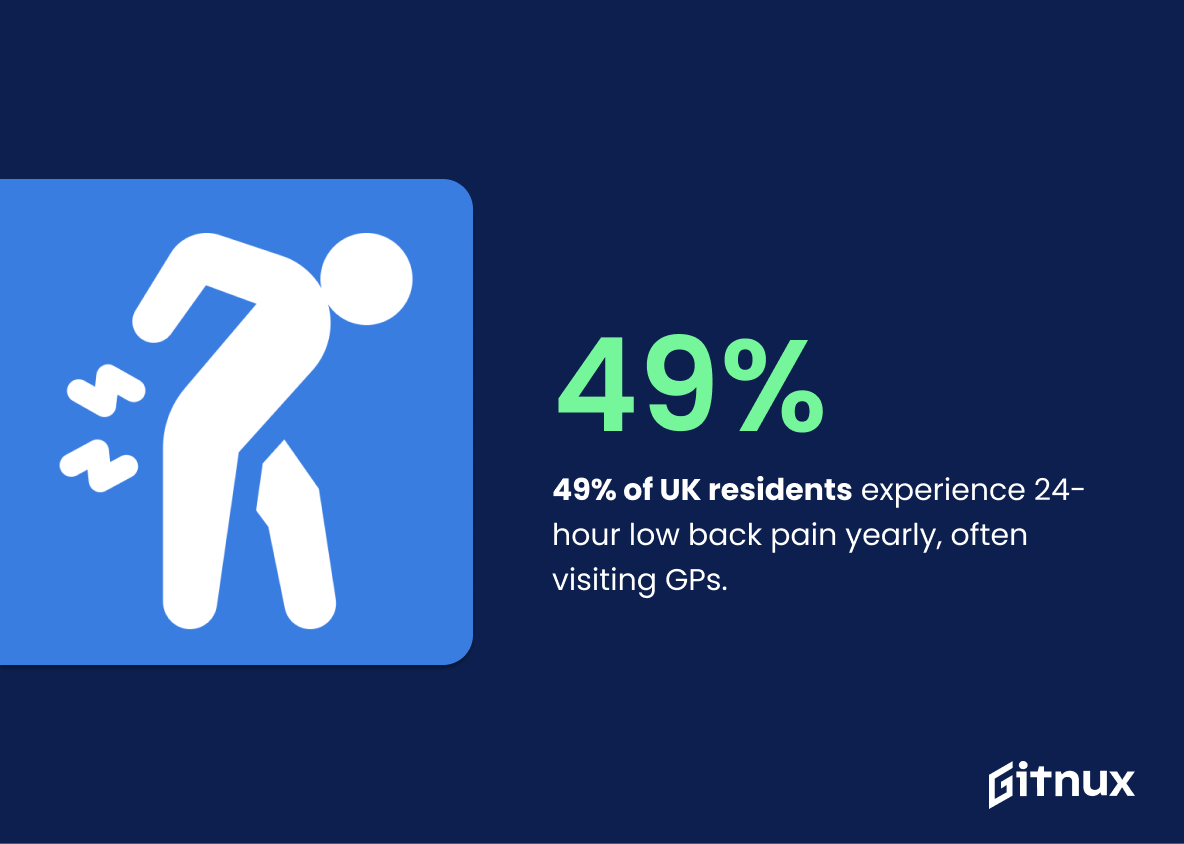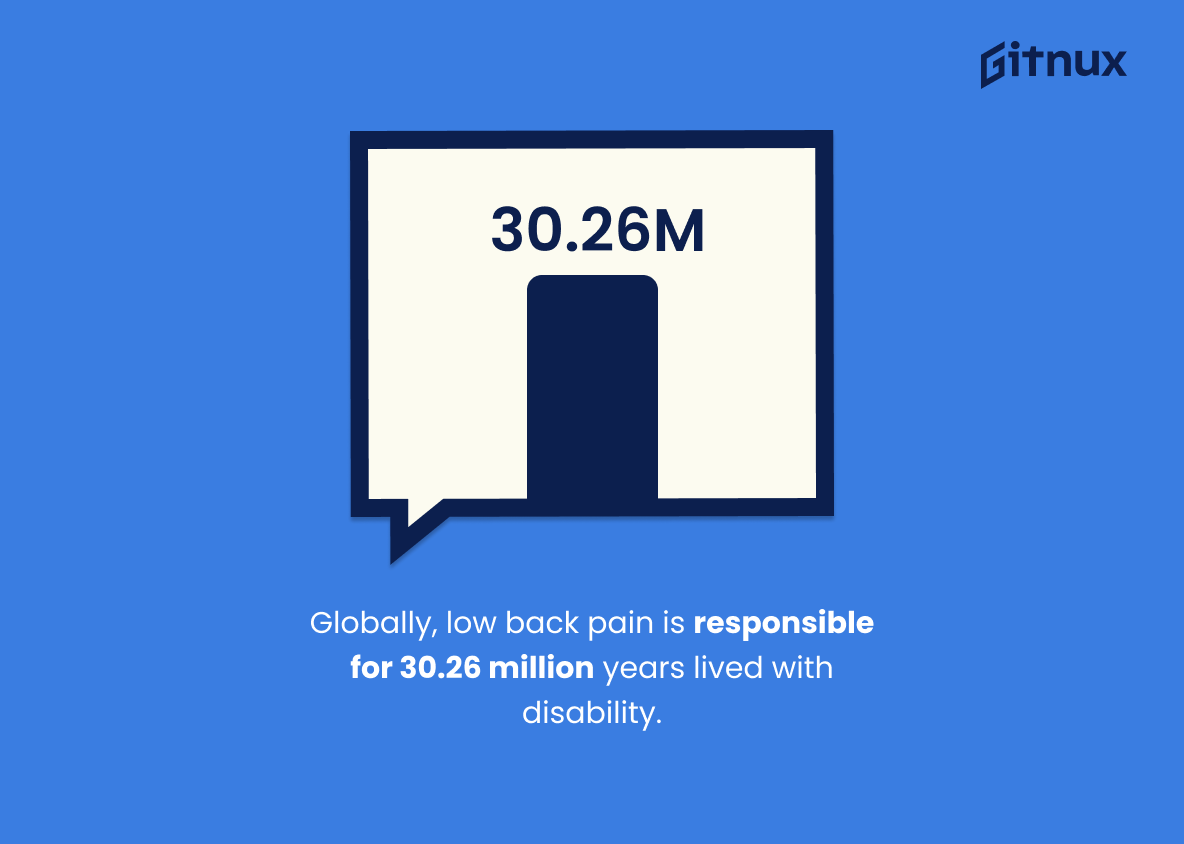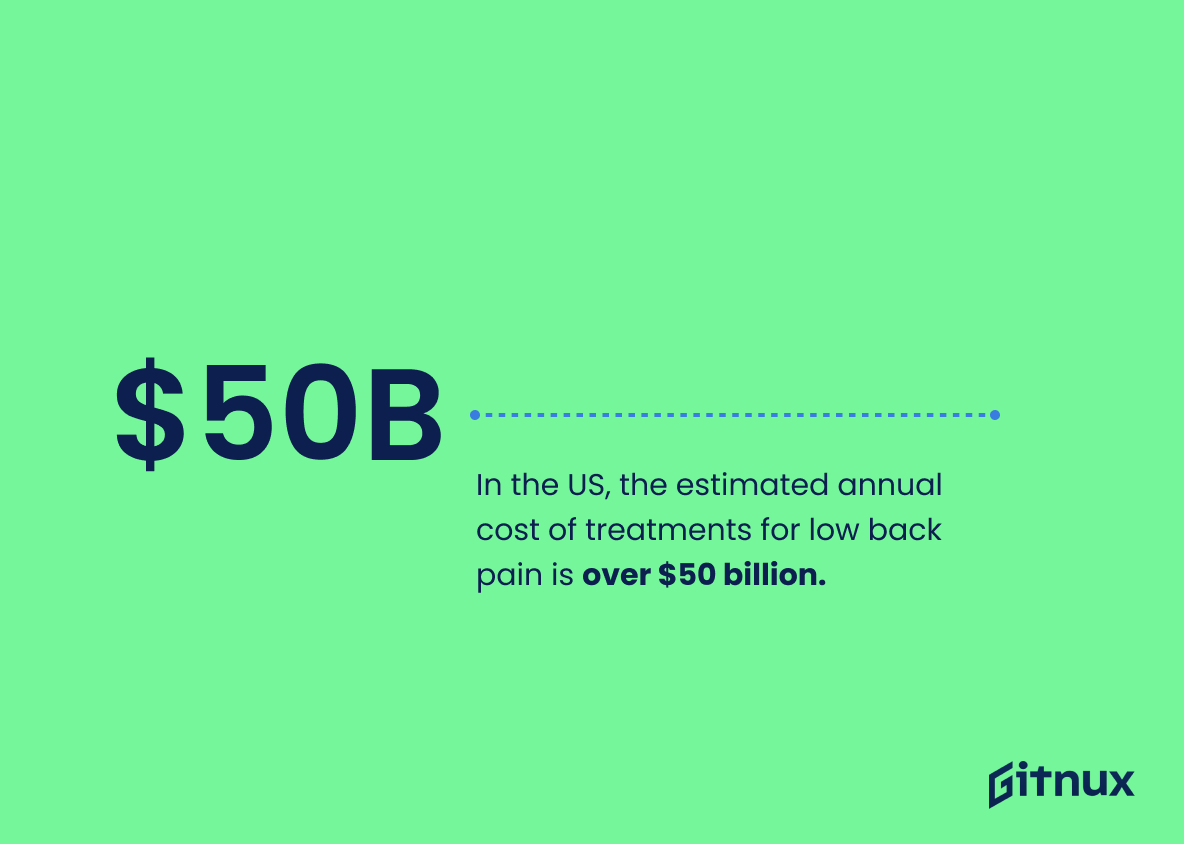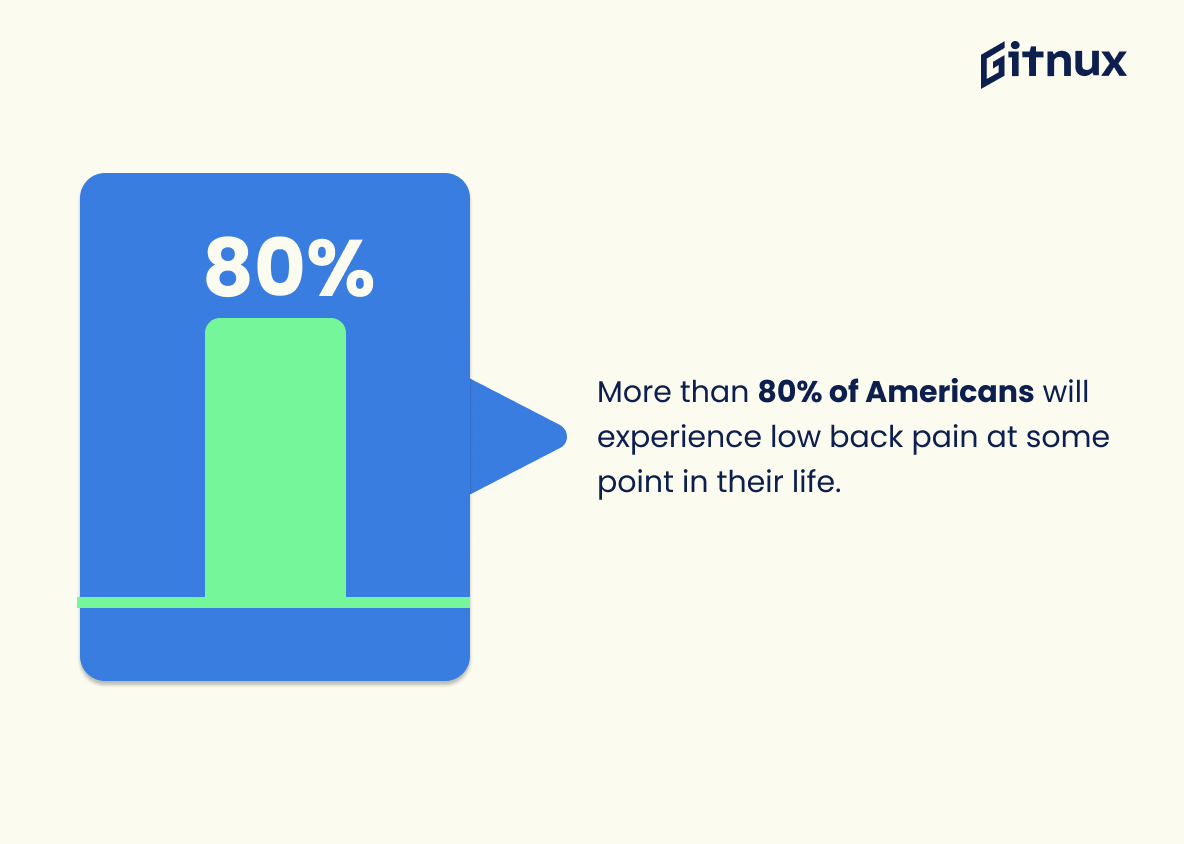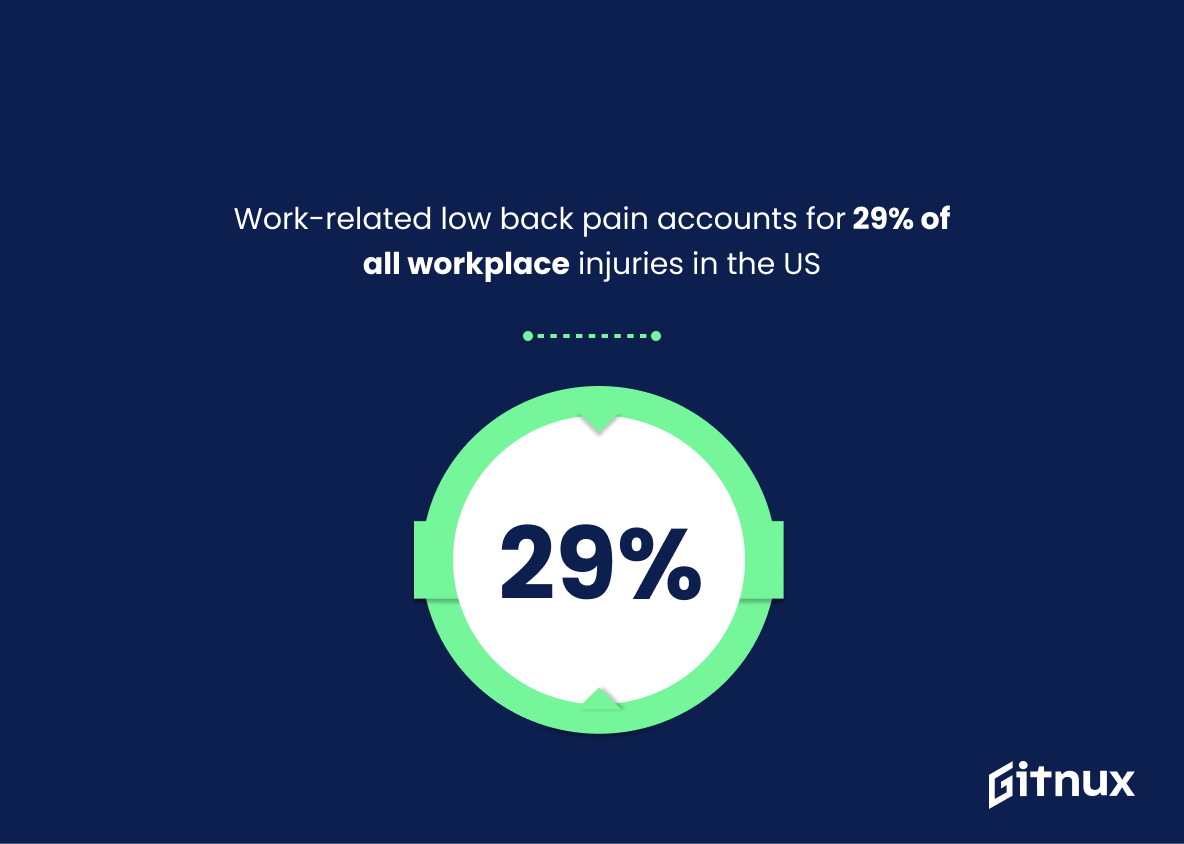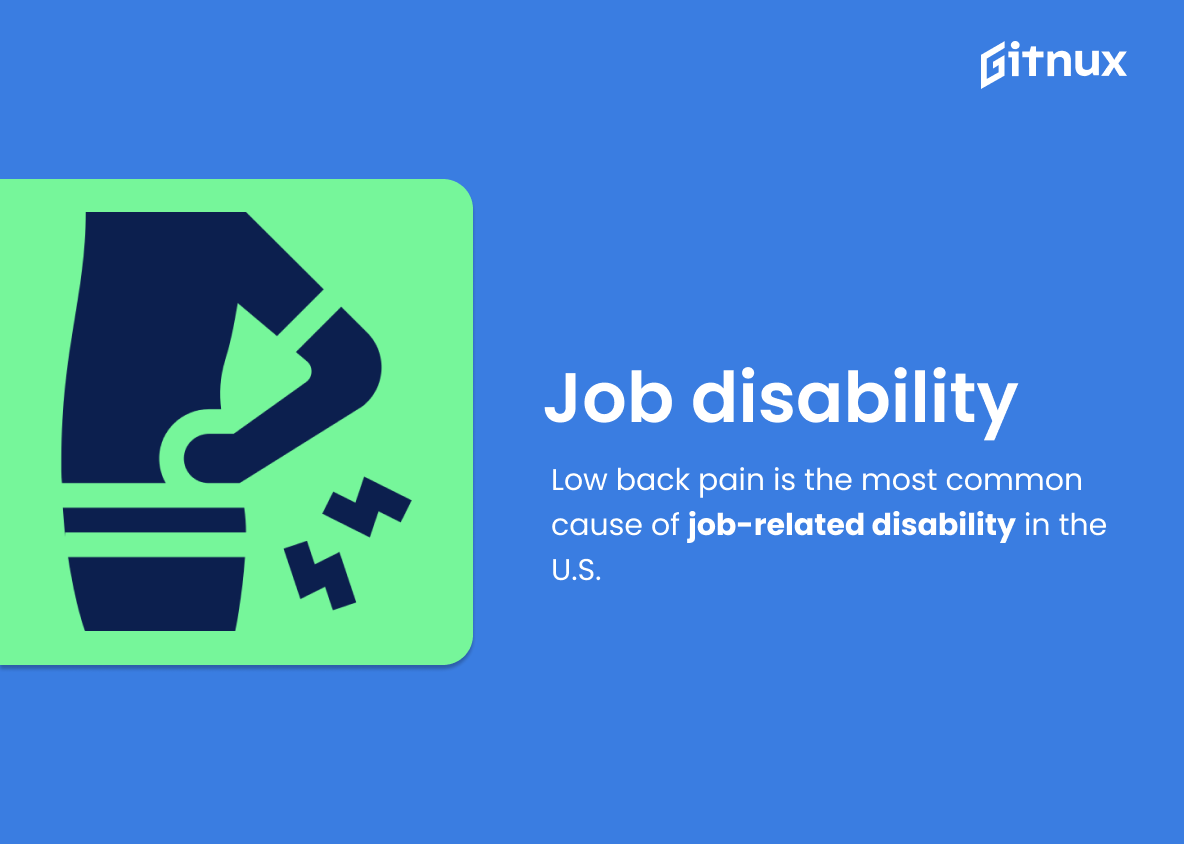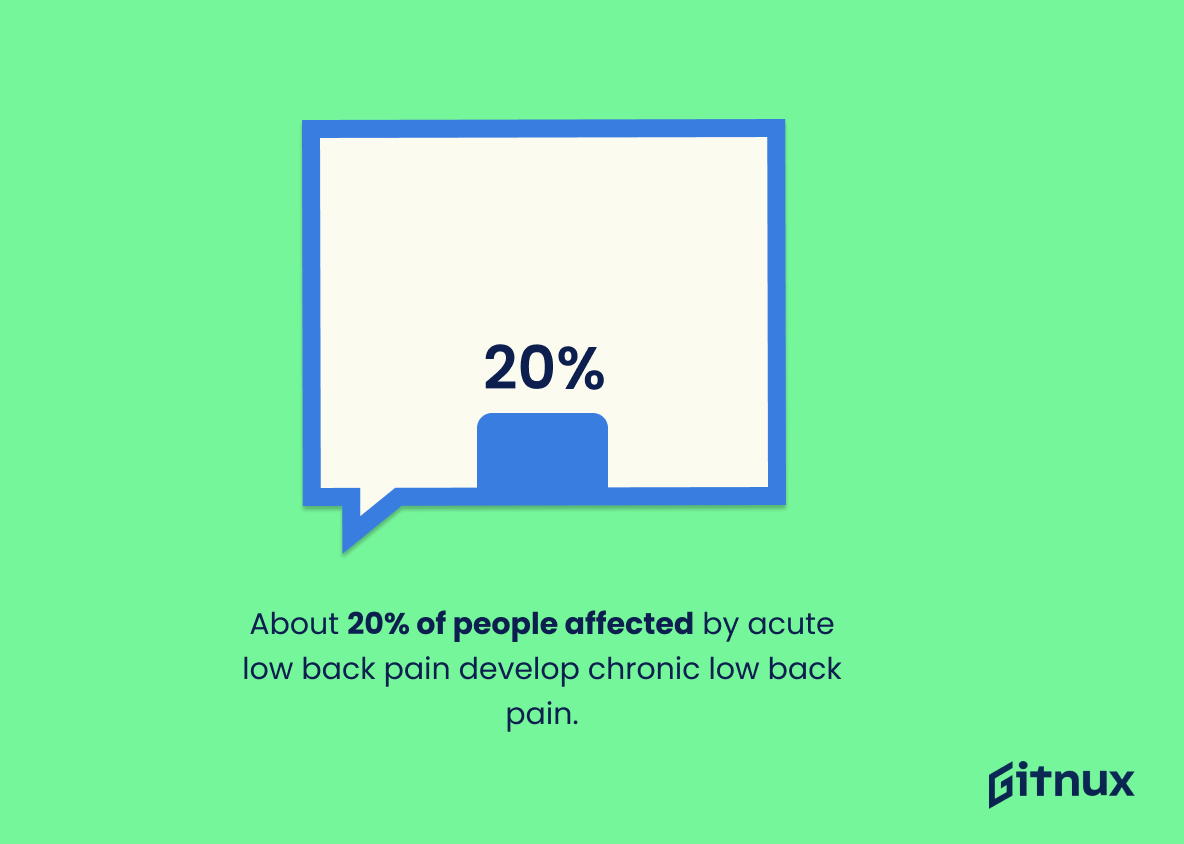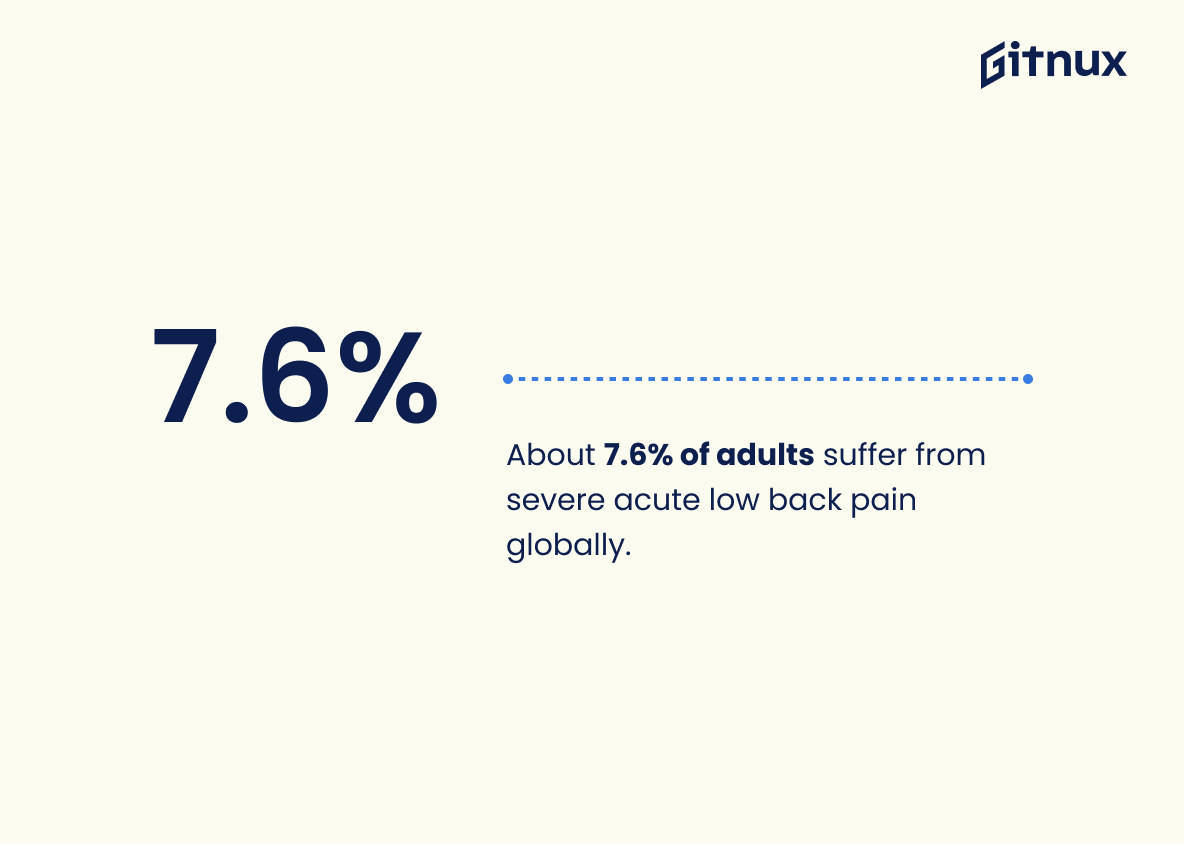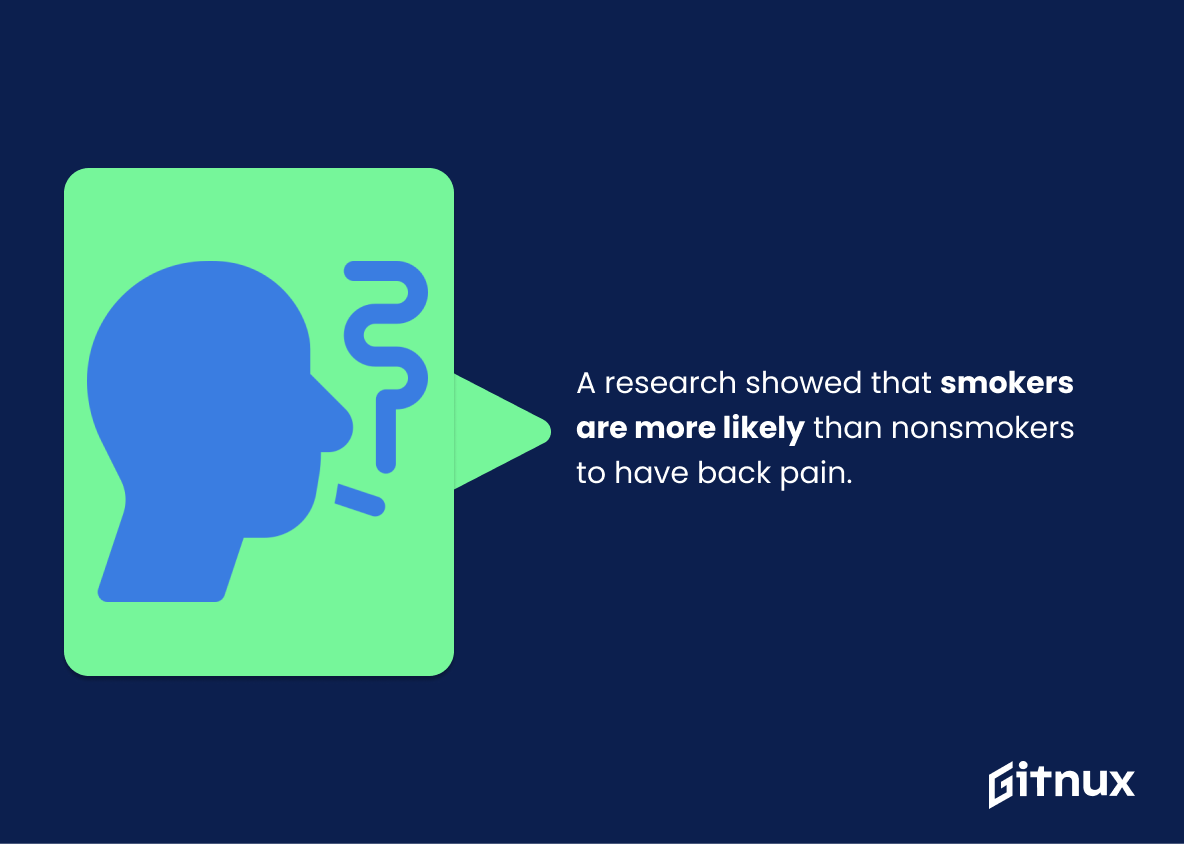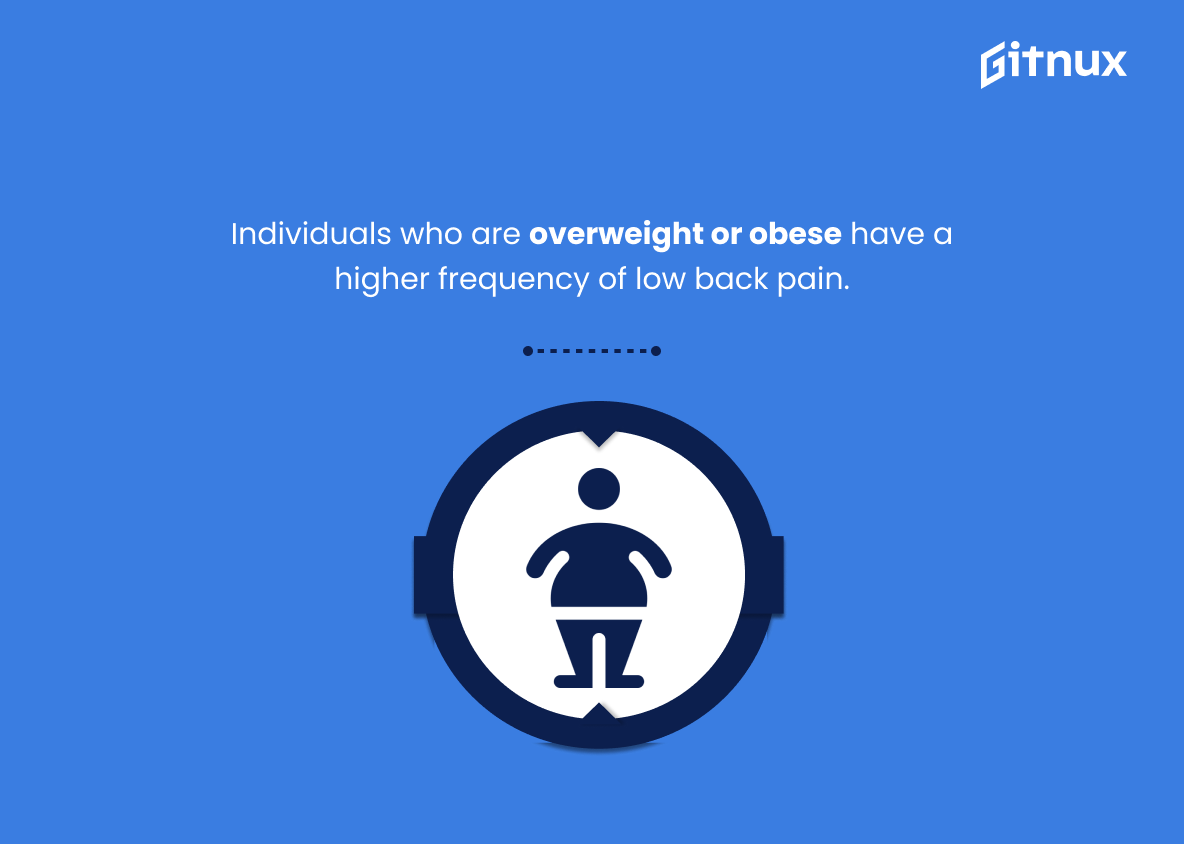In the realm of health issues, low back pain is a common villain that quietly plunders our comfort, productivity, and overall quality of life. Delving into the world of low back pain leads us through an array of surprising statistics, revealing a global phenomenon that affects millions. As you navigate through this blog post, you’ll uncover startling figures about low back pain’s prevalence, its leading causes, and its impact on individuals and society at large.
Understanding these statistics is the first step towards demystifying this affliction and paving the way for effective preventative strategies and treatments. So brace yourself, as we embark on a comprehensive exploration of the world of low back pain through the lens of significant statistics.
The Latest Low Back Pain Statistics Unveiled
Low back pain is one of the most common reasons for GP visits in the UK. 49% of people in the UK may have low back pain lasting at least 24 hours at some point in the year.
Casting a spotlight on the gravity of the issue, the figure 49% is more than just a statistic, it illustrates a nationwide struggle. Half of the UK populace possibly endures low back pain for at least a day in a year, underscoring its prevalence. It’s not merely about numbers, but real people grappling with discomfort and potentially impaired mobility.
As one of the leading causes for GP visits, it punctuates the national healthcare discourse, calling for concerted approaches to mitigate its impact. Highlighting such figures in a blog post on this topic not only provides factual substance, but also underlines the crucial need for awareness, prevention, and effective treatment methods.
Globally, low back pain is responsible for 30.26 million years lived with disability.
Gazing at this remarkable statistic, ‘Globally, low back pain is responsible for 30.26 million years lived with disability’, one cannot help but become acutely aware of the immense burden low back pain inflicts globally. As we navigate through this blog post on low back pain statistics, let this staggering figure act as our compass, guiding us to comprehend the true magnitude and severity of this health concern.
It serves as a potent reminder of the collective time humanity spends incapacitated, imprisoned within their own pain. The statistic paints a vivid picture of the silent pandemic of back pain, pulsating beneath the surface of our everyday lives, and spotlighting the need for focused attention, innovative research, and concerted action in this field.
In the US, the estimated annual cost of treatments for low back pain is over $50 billion
Understanding the monumental annual treatment cost of low back pain, surpassing $50 billion, brings into clear focus the profound financial impact on the US healthcare system. Wrapped within this stunning sum are layers of implications, illuminating the significant economic burdens loaded on the broad shoulders of health insurers, organizations, and individuals.
It underscores the sheer prevalence of the condition and the ongoing need for effective resolution. It’s like shining a glaring spotlight on an aspect of health that necessitates strategic attention and improved management. Eyeing this imposing price tag, one realizes the urgency of advancing research, promoting preventive measures, and optimizing treatment methods for low back pain to alleviate the strain on our health economy.
More than 80% of Americans will experience low back pain at some point in their life
In a world where everybody seems to be on the move, a fascinating key point comes to light amidst the multitude of facts about low back pain that carve out a critical discussion in our blog post. Merely a cursory glance at the figures reveals an intriguing narrative: an overwhelming 80% of Americans are predicted to encounter low back pain at various junctures in their life.
Why should you give this statistic a second glance? Think of it as a mirror reflecting the level of ubiquity of this condition. That is to say, almost everyone you know, at some point in their life, has wrestled or will wrestle with the agonizing grip of low back pain. Be it your family, friends, or colleagues, the pervasiveness of low back pain does not discriminate.
This stark reality underscores the importance of understanding the risk factors, prevention strategies, and treatment modalities for low back pain. So, as you further journey through our blog post filled with enlightening low back pain statistics, remember this broad narrative.
This expansive sweep of Americans affected provides the impetus, highlighting the collective struggle faced and making this not just a personal problem, but a public health issue too. Therefore, our mission of improving awareness, encouraging prevention, and emphasising effective treatment plans of this rampant issue is undeniably essential. Let’s all keep that in mind as we delve deeper into its statistical universe.
Work-related low back pain accounts for 29% of all workplace injuries in the US
Highlighting that almost a third of workplace injuries in the US are related to low back pain acts like a powerful microscope. It immediately brings into sharp focus the gravitas of the situation, turning an otherwise ordinary narrative into a potent statement about the reality of American work life.
Browsing through a blog post on low back pain statistics, a reader might find it startling that a seemingly non-fatal category engenders such a significant chunk of occupational injuries. This statistic becomes the skeleton key that explains why so much emphasis has been placed on prevention, ergonomics, and proper workplace posture: the economic, social, and personal implications are just too considerable to be ignored.
Low back pain is the most common cause of job-related disability in the U.S.
Undeniably, the highlight that low back pain is the leading cause of job-related disability in the U.S takes the center stage in this blog post on Low Back Pain Statistics, not merely as an intriguing fact, but more importantly, as an eye-opening revelation. The gravity of this statistic is emphasized as it vividly illustrates the pervasive and profound impact that low back pain can have on workforce productivity and, by extension, on the economy.
This compelling information does not merely exist to create a shocking headline, but to drive home the urgency and necessity for effective prevention and intervention strategies. Much more than a mere number, this statistic stands as a call-to-arms – underscoring the dire need for employers, health care providers, and individuals to take proactive measures towards mitigating the impacts of this debilitating condition.
About 20% of people affected by acute low back pain develop chronic low back pain.
Delving into the world of Low Back Pain statistics, one cannot dismiss the striking fact that roughly 1 in 5 individuals suffering from acute low back pain ultimately grapple with its chronic form. This intriguing figure serves as a silent yet potent alarm, highlighting that a seemingly innocuous or temporary bout of acute pain holds the capacity to morph into a long-term, relentless nemesis.
It positions us face-to-face with the chilling reality that navigating from ‘acute’ to ‘chronic’ is not an uncanny leap, but a potential, palpable journey, making it stand out as a key element in understanding the comprehensive statistical landscape of Low Back Pain.
About 7.6% of adults suffer from severe acute low back pain globally.
Diving straight into the heart of the pain game, imagine being caught in a crowd of roughly 13 people. Suddenly, like a thunderbolt from the blue, one of you experiences debilitating spasms of low back pain. That’s no random horror; it’s hard fact, as 7.6% of adults worldwide are in the grip of severe acute low back pain.
This alarming figure beautifully illustrates the pervasive nature of this issue, driving home the point that lower back pain is indeed a global villain, not confined to a specific region or demographic. Its significance in a blog post about low back pain statistics is tantamount to shining a high beam on a rampant problem much too common to ignore. So, each time you find yourself in the company of those 13 adults, remember – the back pain beast could be lurking around any one of you.
A research showed that smokers are more likely than nonsmokers to have back pain.
Delving into the fascinating world of low back pain statistics, it’s intriguing to encounter research suggesting a curious link between smoking and increased susceptibility to back pain. Against the mosaic backdrop of data, this insight acts as a striking brushstroke, presenting a perspective where lifestyle choices, specifically smoking, can have a substantial influence on back pain incidence.
This unexpected correlation not only enriches the narrative, beckoning readers to think beyond the surface, but also underscores the fact that prevention strategies need to take into account more than just physical factors. Thus, this statistic lends complexity, depth, and nuance to a blog post on the subject by incorporating factors that one might not immediately associate with low back pain.
Individuals who are overweight or obese have a higher frequency of low back pain.
Delving into the realm of low back pain statistics, we uncover an intriguing correlation linking excess body weight to increased instances of this common aility. Here’s why this nugget of information paves a critical path in our understanding of low back pain.
In the intricate tapestry of low back pain causes, being overweight or obese stands out as a particularly prominent thread. Excess weight puts continuous extra pressure on our lower back, which over time, can lead to chronic discomfort or pain. This trend effectively highlights the significance of maintaining a healthy body weight as a preventative measure against low back pain – a compelling subject for additional discussion and awareness.
Furthermore, the profound implication of these numbers cannot be ignored, especially in societies combating obesity epidemics. This link between body weight and back pain is not just a matter of individual health, it demands broader public health attention and intervention.
In essence, these digits serve as a poignant reminder that our lifestyle choices, specifically body weight, can wield a considerable influence over our back health, effectively molding our understandings and strategies in managing low back pain. Conclusively, these statistics bear warning, beckoning individuals to take conscious control over their weight to safeguard their physical well-being.
Conclusion
In summarizing, the statistics on low back pain illuminate its prevalence and impact on our everyday lives. With the majority of adults likely to experience it at some point, it’s a health issue that bears significant weight on personal wellness, workforce productivity, and healthcare systems globally. Being aware of these statistics can underscore the importance of preventative measures, proper posture, regular exercise, and comprehensive treatment options.
Ultimately, it confirms that no one is alone in this struggle, and it highlights the need for continued research and advancement in managing and treating low back pain. It’s clear from the data that reducing the burden of low back pain is not just a personal, but a humane and socio-economic necessity.
References
0. – https://www.digital.nhs.uk
1. – https://www.www.mayoclinic.org
2. – https://www.pubmed.ncbi.nlm.nih.gov
3. – https://www.www.cdc.gov
4. – https://www.www.acatoday.org
5. – https://www.www.ncbi.nlm.nih.gov
6. – https://www.www.ninds.nih.gov
